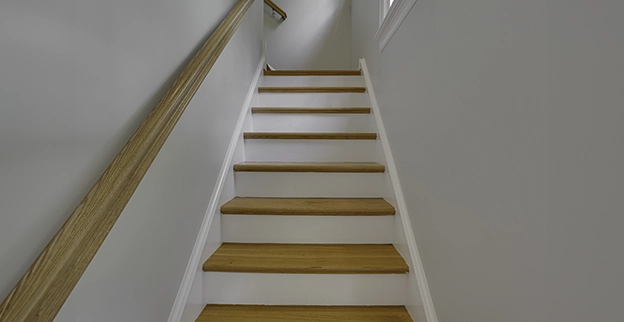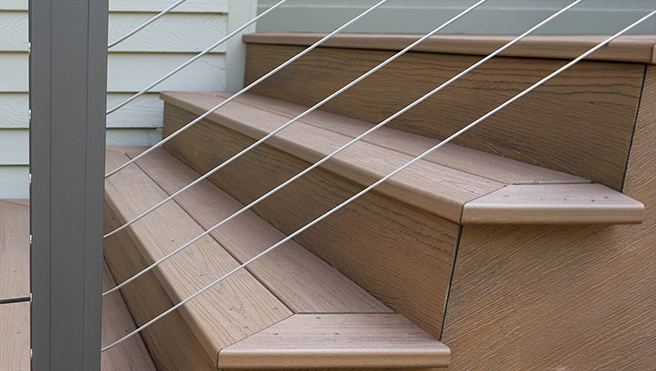Below, we’ve provided a breakdown of all that our Frisco stair repair service entails, as well as answers to some of the most common questions we receive from our customers about this service. To learn more about how we can help you with your stair repair in Frisco, TX, give us a call and we’ll be happy to discuss your project in more detail.
Frisco Stair Repair: What To Expect
If you’re shopping around for stair repair in Frisco, TX, your first question is probably about what our service involves. The better question isn’t what it involves, but what it does not.
There are many different materials for stairs, as well as multiple different styles. Wooden stairs are by far the most common, whether they’re indoor or outdoor stairs. Regardless of style, material or location, there are generally three main components of a stairway:
- Stringers: These boards run along the two sides of your stairway, from the bottom up to the top. Stringers may be ‘open’ or ‘closed’. Open styles have notches cut out of them for the treads and risers to sit directly on top of. In contrast, closed styles have depressions that the sides of treads and risers can fit into for support.
- Treads: The horizontal board of each step that you place your foot on.
- Risers: The vertical board of each step. Risers connect the back of one tread to the front of the next.
Most stairs have railings, as without railings, they can be very dangerous. Very small steps with only a few treads may not require a railing, but anything higher than this should be partially enclosed to prevent accidental falls. Railings are composed of four main components:
- Newel post: A large, vertical post that sits at the bottom and top of each staircase. If your stairway curves or bends, newel posts will also be placed at each direction change.
- Baluster: The smaller vertical posts that fill up space between each newel post.
- Handrail: The perpendicular component that attaches to the tops of each baluster and provides a surface for you to place your hand on when going up and down your stairs.
- Newel cap: Not required but often used in outdoor spaces such as decks, this ornamental or protective cap covers the tops of newel posts.
Our Frisco stair repair technicians can fix issues with any of these components. Not sure which part is causing an issue? No problem! Our technicians are also capable of diagnosing the problem.
Even if you’re sure you know what the issue is, we generally like to start each service out with a visual inspection. If you have creaky stairs, we’ll first conduct an inspection for gaps. As we’ll discuss in more detail below, squeaking tends to occur when components become loose, causing two pieces to rub against each other and produce a creaking sound.
Once we’ve performed an inspection, we’ll be able to determine what steps need to be taken to fix the problem. At Mr. Handyman of Frisco, we pride ourselves on our transparency, honesty, and integrity. To ensure that you stay in the loop throughout the entire process, we will explain our findings, recommend solutions and provide a cost estimate for the required repairs. Depending on the problem, we may be able to get started on your repair that day. If not, we’ll schedule you in for a service appointment at your earliest convenience.
What Leads To Stair Repair In Frisco, TX?
Like many types of home repairs, the need for stair repair in Frisco, TX can be caused by many things. Sometimes it’s as simple as the loosening of joints over a decade of constant use, while other times it’s due to a much more serious problem of water damage. Structural and superficial damages can be caused by multiple things, including:
Moisture Damage
Whether your staircase is covered in vinyl, carpet or tile, beneath these flooring materials is a wood frame. Though wood is widely used in construction, it must be properly prepared and protected, as it is more susceptible to deterioration when compared to materials such as steel and PVC (polyvinyl chloride).
If lumber is exposed to moisture for an extended period of time, it will attract fungi that consume wood fibers, resulting in the process of wood rot. Once wood rot begins, it can be difficult to stop. As wood decays, it becomes soft and crumbles. Evidence of wood rot outdoors may be seen on individual treads or the bottom of loose newel posts. Though wood rot is common, it’s also avoidable. Some of our best suggestions for preventing wood rot include taking the time to reseal your steps every couple of years and ensuring that the wood does not come in contact with the earth.
House Settling
If you live in a newer home and you’ve started to notice some structural issues crop up, it’s likely due to the house settling. While this process is normal, it’s certainly annoying. Before being used in construction, lumber goes through a drying process to reduce its moisture content. In high-humidity environments, wood expands, while in low humidity, it shrinks.
Though lumber is dried in an attempt to reduce the amount it will expand or contract, every climate is different. After the lumber is used in a new build, it takes some time for it to adjust to the environment. As it shrinks or expands, the hardware used to secure the wood moves, resulting in loosened joints that can cause treads to creak and stringers to shift.
Poor Workmanship
Unfortunately, not all builders are reputable. If you’ve hired a stair contractor to do repair work in the past or you’ve moved into a new building and don’t know who was responsible for the carpentry work, there’s a possibility that the problems you’re experiencing now are the result of poor workmanship. Though it doesn’t make it right, builders can end up doing a rush job to meet deadlines.
Leaving problems caused by shoddy workmanship can result in additional damage occurring down the line. When hiring one of our Frisco stair repair experts, you can guarantee that the repair will be done correctly so that you don’t have to keep paying for our services every few years.





